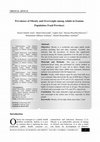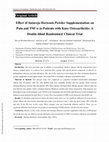Papers by Hassan Mozaffari-Khosravi
DOAJ (DOAJ: Directory of Open Access Journals), 2022
The article's abstract is not available.
Phytotherapy Research, Oct 12, 2022
Journal of nutrition and food security, Feb 10, 2017

International Journal of Pediatrics, Sep 1, 2016
Background Parenting style is associated with children's health-related behaviors. One of the pop... more Background Parenting style is associated with children's health-related behaviors. One of the popularity and applicability assessment tools is Parenting Style and Dimensions Questionnaire (PSDQ) that the lack of Persian version can be seen. This study was conducted to determine the validity and reliability of Persian version of PSDQ. Materials and Methods This study was done with randomized cluster sampling on 588 parents. Cronbach's alpha (α) coefficient was used to determine the internal consistency and Pearson`s correlation coefficients was used to for test-retest reliability and the construct validity. Conformity factor analysis was also, applied to determine the construct validity. Results: Cronbach's α coefficient for two authoritative and authoritarian styles with the highest estimated value were 0.86 and it was 0.41 for permissive style. The results of the correlation test in all three afore mentioned styles were significant. Correlation coefficients between authoritative style and its subscales were about from 0.86 to 0.89 and between authoritarian style and its subscales were about from 0.81 to 0.87. Confirmatory factor analysis showed that goodness-of-fit indices, including CMIN/DF, GFI, CFI, IFI and RMSEA, were 2.1, 0.91, 0.90, 0.90, and 0.04, respectively, which indicated a good the construct validity of instrument. Conclusion: The PSDQ that has been translated into Persian obtained good reliability and validity. PSDQ questionnaire can be considered a useful tool in the assessments and interventions concerning parenting styles used in Iran.

Iranian Journal of Diabetes and Obesity, Jun 10, 2013
Objective: Obesity is a worldwide and major public health problem including Iran and other countr... more Objective: Obesity is a worldwide and major public health problem including Iran and other countries. Available data indicates that the prevalence of obesity has significantly increased among the Iranian population over the past 30 years. The aim of the present study was to evaluate the prevalence of obesity in Yazd (central province of Iran) population. Materials and Methods: This was a cross-sectional population-based study and performed by census method on Yazd population aged 30 years old or above. Height, body weight and Body Mass Index (BMI) were measured. Statistical analyses were performed with Chi-Square test. Results: Totally, 8448 subjects aged>30 years from both sexes were evaluated. Data showed that the rate of BMI above 25kg/m 2 for women and men was 43.9% and 32.2% respectively. In both genders, the rate of obesity and overweight raised by increasing of age up to 50 years old. Overall, the prevalence of obesity was higher in women compared with men in all ages. The prevalence of obesity and overweight were 9.5% and 29%, respectively. Conclusion: This study indicated a high prevalence of obesity and overweight in the central area of Iran, especially in urban people.

PubMed, 2023
Background: Cardiovascular diseases (CVDs) are recognized as one of the leading causes of death w... more Background: Cardiovascular diseases (CVDs) are recognized as one of the leading causes of death worldwide. Studies have shown the impact of genetic predisposition and dietary factors on developing these diseases. Dietary patterns and genetic factors such as polymorphisms related to the level of adiponectin may also interact with each other and produce variances in the effects of these factors on different individuals. The purpose of this study is to investigate the interactions between food intake patterns and polymorphisms on ADIPOQ and ARL15 genes in relation to cardiometabolic risk factors. Methods: This cross-sectional study is conducted on 380 adults (20 to 70 years old) living in Yazd, Iran. Individuals were selected from the participants in Yazd Health Study (YaHS) and its sub-study called Taghziyeh Mardom-e Yazd (TAMYZ) after reviewing the inclusion and exclusion criteria. YaHS is a population-based cohort study which has been conducted on 9962 adults living in Yazd since 2014. In the present study, rotated principle component analysis (PCA) with Varimax rotation is used to identify the major dietary patterns. The polymerase chain reaction-restricted fragment length polymorphism (PCR-RFLP) method is used in order to identify rs1501299 and rs6450176 variants (on ADIPOQ and ARL15 genes, respectively). General linear models (GLM) as well as regression models are used to investigate the interactions between the studied genotypes and the extracted dietary patterns. Conclusions: The results of this study can help to personalize dietary recommendations for the prevention of CVDs according to the genetic predisposition of individuals.
Cureus, Jun 13, 2023
Mohseni-Takalloo et al. This is an open access article distributed under the terms of the Creativ... more Mohseni-Takalloo et al. This is an open access article distributed under the terms of the Creative Commons Attribution License CC-BY 4.0., which permits unrestricted use, distribution, and reproduction in any medium, provided the original author and source are credited.
Iranian Journal of Reproductive Medicine, Jun 10, 2023
The purpose of this study is to test the effects of Dietary Approaches to Stop Hypertension (DASH... more The purpose of this study is to test the effects of Dietary Approaches to Stop Hypertension (DASH) diet plan on pregnancy outcomes patients with gestational diabetes mellitus. This randomized controlled clinical trial was performed among 33 women diagnosed with gestational diabetes. These patients were randomly distributed to the control group (n = 16) or DASH diet group (n = 17) for 4 weeks. Whereas 47.1% of women in the DASH diet needed to have a cesarean section, this percentage of mean gestational age in control diet was 81.3% (p<0.01). Approximately 23.5% of women in the DASH diet and 75% of women in control diet needed to commence insulin therapy after intervention (p<0.01). In conclusion, the effect of DASH diet improved pregnancy outcomes patients with gestational diabetes.
Clinical nutrition ESPEN, Aug 1, 2023
Saudi Journal of Kidney Diseases and Transplantation, 2021
Ninety individuals were included in this case-control study:30 type 2 diabetes mellitus, 30 pre-d... more Ninety individuals were included in this case-control study:30 type 2 diabetes mellitus, 30 pre-diabetes and 30 healthy individuals (males and females, age: 25-65, body mass index: 25-35). MicroRNAs expression was determined by real-time polymerase chain reaction. Furthermore, plasma concentrations of tumor necrosis factor alpha (TNF-α) and interleukin 6 (Il-6) and fasting insulin was measured by enzyme-linked immunosorbent assay. Homeostatic model assessment for insulin resistance (HOMA-IR) was calculated as an indicator of insulin resistance.
Journals of Community Health Research, Jul 10, 2013

Introduction: The most prevalent type of arthritis is osteoarthritis which is known with the dege... more Introduction: The most prevalent type of arthritis is osteoarthritis which is known with the degenerative knee disease. Limited pieces of evidence have indicated that satureja with special phenol compounds is effective in inflammation reduction and pain alleviation. The aim of this study was to investigate the effect of Satureja Hortensis powder supplement on pain improvement and serum TNF-α in patients with knee osteoarthritis (OA). Materials & Methods: The present study was conducted as a placebo-controlled double-blind randomized clinical trial. 39 patients with OA with medium pain were randomly divided into two groups which received Satureja Hortensis powder (SG) and placebo (PG) These groups consumed three 200 mg capsules with the same size and form for two months which contained Satureja Hortensis powder and starch, respectively. Pain intensity was determined using visual analogue scale 5(VAS) at the beginning and end of the trial. Response to the treatment was defined as pain reduction by more than 1.5 scores. The concentration of TNF-α were measured with ELISA kit. Results: To distribute pain intensity before the intervention, there was no significant difference between the two groups. Before the intervention, all people had a pain score between 4 and 7. After the intervention, 95% of the SG and 84% of the PG were in this scope. These changes were not statistically different (p=0.12). There was no significant difference between the two groups in concentration of TNF-α before and after the intervention. Conclusion: Results of this study showed that Satureja Hortensis powder supplement with dose of 600 mg per day for 60 days was not effective on pain alleviation and concentration of TNF-α in patients with knee osteoarthritis
Tolooebehdasht, Mar 15, 2016
Obesity Medicine, Jun 1, 2020
This is a PDF file of an article that has undergone enhancements after acceptance, such as the ad... more This is a PDF file of an article that has undergone enhancements after acceptance, such as the addition of a cover page and metadata, and formatting for readability, but it is not yet the definitive version of record. This version will undergo additional copyediting, typesetting and review before it is published in its final form, but we are providing this version to give early visibility of the article. Please note that, during the production process, errors may be discovered which could affect the content, and all legal disclaimers that apply to the journal pertain.

PubMed, May 1, 2016
Introduction: Carnitine supplementation may improve the general health and quality of life of hem... more Introduction: Carnitine supplementation may improve the general health and quality of life of hemodialysis patients by improving adipokines levels. The aim of the study was to investigate the effects of L-carnitine supplementation on leptin levels, adiponectin levels, and body weight of hemodialysis patients. Materials and methods: Fifty hemodialysis patients were randomly divided into the carnitine group, who received oral L-carnitine, 1 g/L for 3 months, and the control group. Anthropometric measurements and serum levels of adipokines were measured at baseline and at the end of the intervention. Results: Forty-two participants completed the study. Serum leptin concentrations decreased after 12 weeks of the intervention in both groups, but these changes were not significant. The mean change of leptin concentration were, -1.7 ± 19.0 µg/mL and -7.1 ± 20.0 µg/mL in the carnitine group and the control group, respectively (P = .39). The mean adiponectin levels at baseline and after the intervention were 8.6 ± 11.19 µg/mL and 9.8 ± 4.1 µg/mL in the carnitine group (P = .67) and 5.0 ± 2.5 µg/mL and 11.2 ± 5.4 µg/mL in the control group, respectively (P < .001). Serum adiponectin levels increased significantly in the control group only. The decrease in body mass index was not significant. Conclusions: This study showed that a daily supplementation of 1000 mg oral syrup of L-carnitine for 12 weeks did not affect leptin and adiponectin levels or the body weight or body mass index of hemodialysis patients.
Trials, Nov 30, 2020
Background: The prevalence of prediabetes is increasing worldwide. Unfortunately, prediabetes is ... more Background: The prevalence of prediabetes is increasing worldwide. Unfortunately, prediabetes is related to noncommunicable diseases. A high risk of developing type 2 diabetes mellitus (T2DM) is reported in people with prediabetes. Curcumin, a polyphenol, might lead to its therapeutic role in obesity and some obesity-related metabolic diseases. Zinc is a trace element that plays a key role in the synthesis and action of insulin, carbohydrate metabolism, and decreasing inflammation. There has been no clinical trial of zinc and curcumin cosupplementation in patients with prediabetes. In previous studies, the single administration of zinc or curcumin has not been conducted on many of the studied markers in prediabetic patients.

International Journal for Vitamin and Nutrition Research, Aug 1, 2014
. Objective: This 12-week randomized placebo controlled clinical trial investigated the effect of... more . Objective: This 12-week randomized placebo controlled clinical trial investigated the effect of Coenzyme Q10 (CoQ10) on diabetic neuropathy, oxidative stress, blood glucose and lipid profile of patients with type 2 diabetes. Methods: Diabetic patients with neuropathic signs (n = 70) were randomly assigned to CoQ10 (200 mg/d) or placebo for 12 weeks. Blood samples were collected for biochemical analysis and neuropathy tests before and after the trial. Results: There were no significant differences between the two groups in terms of mean fasting blood glucose, HbA1c and the lipid profile after the trial. The mean insulin sensitivity and total antioxidant capacity (TAC) concentration significantly increased in the Q10 group compared to the placebo after the trial (P &lt; 0.05). C-reactive protein (hsCRP) significantly decreased in the intervention group compared to placebo after the trial (P &lt; 0.05). In the control group, insulin sensitivity decreased and HOMA-IR increased, which revealed a significant difference between groups after the trial. Neuropathic symptoms and electromyography measurements did not differ between two groups after the trial. Conclusions: According to the present study, CoQ10, when given at a dose of 200 mg/d for 12 weeks to a group of neuropathic diabetic patients, did not improve the neuropathy signs compared to placebo, although it had some beneficial effects on TAC and hsCRP and probably a protective effect on insulin resistance.

Research Square (Research Square), Oct 1, 2021
Background: Diabetes is one of the major public health concerns. Pre-diabetes can increase the ri... more Background: Diabetes is one of the major public health concerns. Pre-diabetes can increase the risk of developing some non-communicable diseases such as type 2 diabetes. Given the increasing trend of prediabetes, it is critical to control it and prevent its complications. Curcumin is a major bioactive component of turmeric. Zinc is an antioxidant nutrient. The present trial aimed to evaluate the effect of curcumin and zinc co-supplementation along with a loss-weight diet on serum lipid pro les in overweight or obese patients with pre-diabetes. Methods: Eighty-four participants were randomized to four groups (curcumin (500 mg/day), zinc (30 mg/day), "curcumin & zinc", and placebo) for 90 days. Serum total cholesterol (TC), low-density lipoprotein (LDL), high-density lipoprotein (HDL), triglycerides (TG), non-HDL, HDL/LDL ratio, weight, BMI, waist circumstance (WC), hip circumstance (HC), physical activity (PA) and dietary intake were determined pre and post-intervention. This study will be conducted at Yazd Diabetes Research Clinic, Shahid Sadoughi University of Medical Sciences. Results: Totally, 82 participants were included in the nal analysis. After the adjusted PA effect, changes in serum TG (adjusted p = 0.001), LDL (adjusted p = 0.035), non-HDL (adjusted p =0.003), HDL/LDL ratio (adjusted p =0.002), and HDL (adjusted p < 0.0001) revealed a signi cant difference between the groups. However, the changes in weight (adjusted p = 0.004) and BMI (adjusted p = 0.006) were signi cant but the changes in dietary intake, PA, WC, and HC were non-signi cant (adjusted p ≥ 0.05). Despite that there was a signi cant difference for post-intervention HDL levels (adjusted p = 0.016), other lipid pro les showed no signi cant difference (adjusted p ≥ 0.05). Conclusion: The bene cial effects of "curcumin & zinc" co-supplementation was reported for the changes of some lipid pro les (TG, LDL, HDL, non-HDL, and HDL to LDL ratio), BMI, and weight with no positive effects on TC, dietary intake, PA, WC, and HC. Therefore, it may play a potential role in the prevention of macro and microvascular complications. Trial registration: The project is a registered clinical trial (Registration number: IRCT20190902044671N1,









Uploads
Papers by Hassan Mozaffari-Khosravi